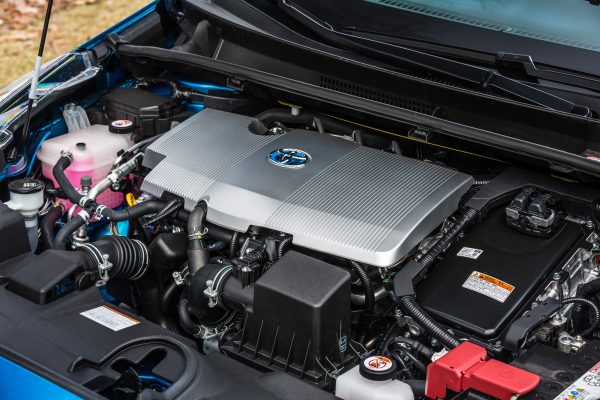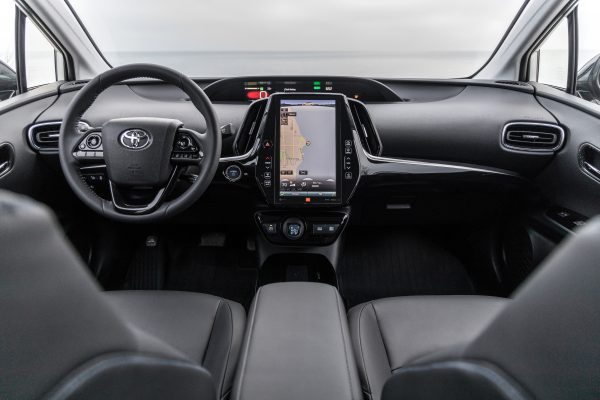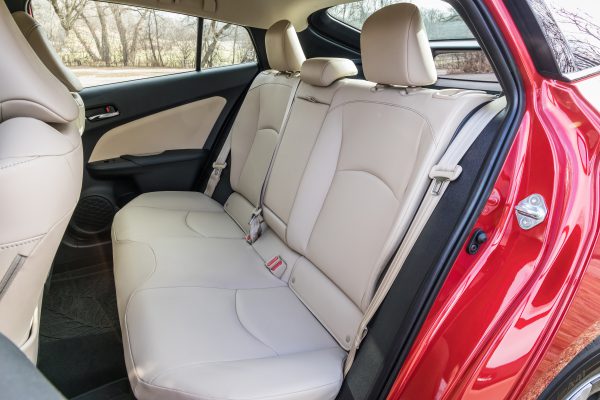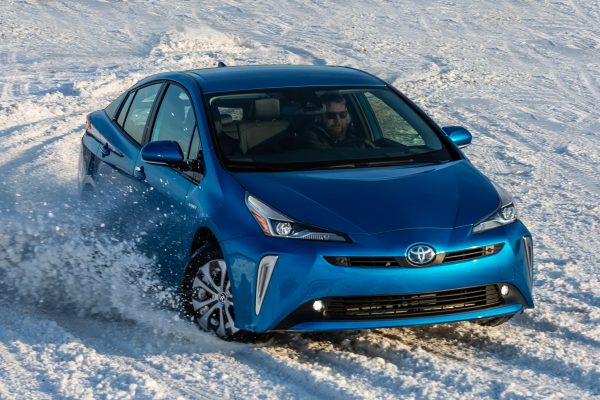Gasoline Station Nemesis
Does 52 miles per gallon have a nice ring to it? This is what the 2019 Toyota Prius Limited hybrid is rated at by the EPA. Not enough for you? Well then, how about the 56.7 mpg Clean Fleet Report got during a week of driving throughout Southern California. Our time in the Prius Limited only covered 345 miles, so we barely dented the 11.3-gallon fuel tank. If we had drained it, we would gone about 640 miles before refilling. This is more than San Diego to Napa or just shy of Boston to Cleveland or Miami to Atlanta. To say the least, the Prius Limited is a fuel sipper, and it does so comfortably on the open road or around town.
The Sales Leader

When the first Prius went on sale in North America in 2000, it was new in many ways. First, it was an all-new car, as in no one had never seen one before. More importantly, it was new as it was powered by gasoline and electricity. As the first mass-produced, commercially available hybrid vehicle, it was praised, nay worshiped, by some. Due to its cheese wedge shape and radical power plant, it was ridiculed and scoffed at by others. Now some 19 years later and into its fourth generation, the Toyota Prius is the best-selling hybrid vehicle in the world, including America.
Driving a Hybrid
The Toyota Hybrid Synergy drive technology, shared with the all-new 2020 Corolla Hybrid, consists of a 1.8-liter four-cylinder engine, with two motor/generators producing a combined 121-horsepower. The front wheels are driven by an electronically-controlled continuously variable transmission (ECVT), with four driver-selectable drive modes—EV, Normal, Eco and Sport. Acceleration is most spirited in the Sport mode, with high fuel efficiency when in the Eco and Normal modes. The EV mode, for driving around at slow speeds on pure electric, has a limited range, but makes for a great way to not use any gasoline when in parking lots, crowded streets and even in stop-and-go highway traffic jams.

The 2019 Toyota Prius comes with two different batteries. The Prius Limited, tested by Clean Fleet Report, had a lithium-ion battery as does the L, Eco, LE and XLE trim levels. The LE AWD-e, XLE AWD-e have a nickel-metal hydride battery. In all models regardless of the battery, the battery is placed under the seats, which increases interior space for passengers and cargo and drops the center of gravity, thus aiding handling. Both types of batteries are charged through regenerative braking. This energy recovery system takes the usually wasted friction and heat from braking or coasting and converts kinetic energy into stored energy. The process of using and restoring electricity to the battery can be watched in real time on dash gauges.
Zero-to-60 times are in the mid-10-second range, so you will need to push the accelerator pedal all the way down to get the momentum going. However, this isn’t why you buy a Prius. As noted earlier, going more than 50 miles for every gallon of gas is the siren call of the 2019 Toyota Prius Limited.
On the open road the Prius Limited was easy-to-drive, tracking well with a stable and sure ride. Cornering ability is only within the limits of the 15-inch tires, which let you know real quickly when they have been pushed too far and too hard. The bottom line is the car is not exciting to drive, but then again, Toyota is not marketing it as a sporty car—they offer the 86 and Supra for that.
Interior
The center console has been redesigned for 2019 to house a larger touchscreen for the navigation and infotainment system. The 11.6-inch vertical, high-resolution touchscreen is where all controls are, except for the audio and telephone controls that can also be found on the steering wheel. What we miss are knobs, buttons and switches—of any kind. The upgraded JBL Premium audio system with 10-speakers, offered AM/FM cache radio, SiriusXM, Siri Eyes Free, and iPod connectivity through multiple USB ports. Music streaming and hands-free telephone were through Bluetooth.

As with previous Prius models, the gauges are centered on the dash, not directly in-front of the driver. Toyota addressed this by adding a color Head-up display that shows the speedometer, navigation and hybrid drive system information. This helps some, but not enough, as there is just something not quite right about always looking to your right to check driving information. The Qi wireless smartphone charging is a nice feature.
The interior is roomy, and with plenty of light coming in, airy and bright. The optional power tilt-and-slide moonroof added to the open feeling, making it a nice place to hang-out, especially on long fuel-efficient road trips. The seats on the Limited model were covered in SofTex, which is a synthetic leather material designed for wear, easy cleaning and resisting spills. Its production process is more environmentally friendly than leather, and also does not include any animal-based material.

There was plenty of headroom for the front occupants, whose seats were heated, with the driver getting six-way power adjustments and the passenger four-way. The rear seat folds flat and splits 60/40, comfortably accommodating two full-size adults, three on short trips. Leg and head room for those in the rear was good, plus new for 2019 are two rear USB ports.
Exterior
The 2019 Toyota Prius received a mild update with what Toyota calls “a newly refined front and rear exterior styling, including an all-new front bumper, headlamp and taillamp design.” The reality is it looks like a Prius, which stands-out from all other cars. It may not be everyone’s first choice, but the unique styling results in low aerodynamic drag and tells the world the owner is doing something good for the environment—maybe even lessening their carbon footprint. Everything helps.
Safety, Pricing and Warranties
All Prius models comes with an extensive list of standard safety features, including front, side and knee airbags, and the Star Safety Sense system. This bundle includes active safety features of pre-collision and pedestrian detection, lane departure alert, dynamic radar cruise control, lane tracing assist and many more. Talk with your Toyota sales representative about the robust list standard safety features on the 2019 Prius.

The 2019 Toyota Prius comes in eight different trim levels, with base MSRPs ranging from $23,770 to $33,350. Options are additional, as is the $930 processing and handling fee.
The 2019 Prius has been tested by the National Highway Traffic Safety Administration (NHTSA) and received 5 Stars, its highest safety rating. The Insurance Institute for Highway Safety (IIHS) awarded the Prius its Top Safety Pick.
The 2019 Prius comes with these warranties:
- Hybrid System – Eight years/100,000 miles
- Powertrain – Six years/60,000 miles
- Basic – Three years/36,000 miles
- Corrosion Perforation – Five years/Unlimited miles
- Roadside Assistance – Three years/36,000 miles
Observations: 2019 Toyota Prius Limited
The big news in 2019 for the Toyota Prius is it being available in all-wheel drive, AWD. Clean Fleet Report’s Prius Limited was front-wheel drive, which is what the vast majority of Prius buyers will opt for. But if you live where snow frequently covers the roads, the Prius AWD-e models should be on your shopping list.

The stellar fuel economy of Toyota’s electrified vehicles vaults them over and above most, if not all, cars on the road without a plug. The 2019 Toyota Prius Limited offers smooth operation and a seamless transition between gasoline and electric drive modes. The easy driving attributes make it a serious contender for anyone who takes frequent long trips or has a daily commute.
Toyota’s reputation for high reliability is well-earned, with multiple generations of loyal owners. This too goes for the Prius, where owners are experiencing nearly 600 miles of hybrid driving range. Stopping to fill their tank is a far less common part of their life. Sounds intriguing.
Is it time you said goodbye to a gasoline-only engine and put some electricity into your life? If so, visit your Toyota dealer and take one of the Prius models for a lengthy test drive.
Whatever you end up buying, Happy Driving!
Make sure to opt-in to the Clean Fleet Report newsletter (top right of page) to be notified of all new stories and vehicle reviews.
Related Stories You Might Enjoy—Toyota’s Hybrid Choices
Road Test: 2020 Toyota Corolla Hybrid
Comparison Test: A Pair of Toyota Prius
Road Test: 2019 Toyota Avalon Hybrid
Road Test: 2019 Toyota Camry Hybrid
Road Test: 2019 Toyota RAV4 Hybrid
Disclosure:
Clean Fleet Report is loaned free test vehicles from automakers to evaluate, typically for a week at a time. Our road tests are based on this one-week drive of a new vehicle. Because of this we don’t address issues such as long-term reliability or total cost of ownership. In addition, we are often invited to manufacturer events highlighting new vehicles or technology. As part of these events we may be offered free transportation, lodging or meals. We do our best to present our unvarnished evaluations of vehicles and news irrespective of these inducements.
Our focus is on vehicles that offer the best fuel economy in their class, which leads us to emphasize electric cars, plug-in hybrids, hybrids and diesels. We also feature those efficient gas-powered vehicles that are among the top mpg vehicles in their class. In addition, we aim to offer reviews and news on advanced technology and the alternative fuel vehicle market. We welcome any feedback from vehicle owners and are dedicated to providing a forum for alternative viewpoints. Please let us know your views at publisher@cleanfleetreport.com.

1 thought on “Road Test: 2019 Toyota Prius Limited”